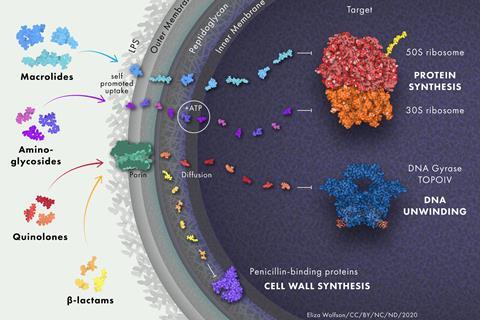Eliza Wolfson illustrates biological and scientific concepts for a variety of different audiences. Our Careers Editor Louise finds out what life is like as a scientific illustrator and gets Eliza’s tips for how to become one.
What is a SciArtist?
Anyone who makes art (images, sculptures, sounds, stories, poems, whatever you can think of) about science. Which encompasses quite a lot! That includes scientists who display or interpret their data for its beauty. Or artists who create art around scientific topics. This can be illustrative, like me – depicting what discoveries might look like – or it can be interpretive or responsive. In between these extremes of data for data’s sake and art for art’s sake, there are graphic designers. They develop branding, logos, infographics and diagrams based on and around scientific topics, guided by aesthetic principles. I do that too.
How do your skills help scientists?
Most often it is a valuable way to communicate scientific findings to their community and beyond – a picture can paint a thousand words. It can add emotion, analogy, context and meaning. However, sometimes by drawing their scientific models, my skills also help my clients explicitly visualise the bits still missing or a new perspective. I’ve mostly worked with academics, but also start-ups, charities, museums and learned societies like Microbiology Society, FEMS and Royal Meteorological Society.

How did you end up becoming a SciArtist?
To be honest, I think I always was! Drawing my observations and ideas as diagrams has always helped me understand scientific concepts, and careful experimentation with media and techniques has always improved my art.
I found my PhD hard, so I doodled on the whiteboard in the lab to cheer myself up. These doodles got me noticed – I was asked to illustrate a review by my PI. They bought me Photoshop and I slowly learned how to use it alongside my benchwork. I used Photoshop to illustrate for the university science magazine and the sci-comm activities I became embroiled in. I toyed with going into sci-comm, but it was really the illustration that I craved.
Then I ended up in a 4-year postdoc I didn’t like, shortly after my parents had died. I didn’t have the emotional energy to push through it, so I left halfway through. I took some time out to draw bacteria and regroup. It felt good, so I gave myself a year to see if that could work. Importantly, I spread the word too. That was over 7 years ago. I recognise I was able to do this partly because my parents died – I had a financial buffer at the beginning – but also partly because I knew enough scientists who knew my work to get started with commissioned work.
What do you love and hate most about being a SciArtist?
I love the variety of science I get to hear about, understand and make visible in a variety of ways; I’m always learning. I hate the business side of things – it takes more time than you’d think!

What tips would you give an artistic scientist to launch into this sort of work?
- Save at least 6 months of salary to give you a bit of a buffer when you take the plunge. This is the bit that absolutely sucks and biases the area towards privilege.
- Tell people what you’re doing, get them rooting for you, and get work by word of mouth. It helps hugely to have a bunch of people to commission you from the beginning.
- Build a portfolio of art on subjects and in styles you want to do more of. People who commission illustrations generally do this based on what they’ve already seen. Make it easy for them.
- Teach yourself to use the software you need – I’m forever learning and that’s part of the fun. Don’t be intimidated, just dabble!
- Be aware of who is already out there. Try and offer something unique to you. When you’re more established, spread the love by recommending people for work you can’t do. Illustration can be quite a solitary profession, so try not to make it more so!
- Be open and flexible with how clients like to work with you but set clear boundaries at the beginning. If you both know what timing, costs and usage to expect, nothing can’t be achieved without a bit of communication.
- Value your time and skills and charge sustainably, otherwise you’re subsidising your clients. If you never hear, ‘That’s too expensive!’, then you’re probably not charging enough.
- There’s no one way to go about this and there are lots of business models to be aware of beyond getting commissions – selling originals, prints, print on demand, craft fairs, Etsy, workshops, grants and residencies… There are pros and cons for all of them – find what mix works for you.
- And finally, persistence. A certain amount of getting work is just having hung around for long enough for people to think of you as someone who does that thing, which takes time.
Explore more of Eliza’s work here.








No comments yet